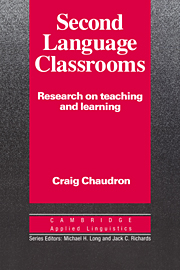Book contents
- Frontmatter
- Contents
- List of tables and figures
- Series editors' preface
- Preface
- 1 Major issues in second language classroom research
- 2 Classroom research methods
- 3 Teacher talk in second language classrooms
- 4 Learner behavior in second language classrooms
- 5 Teacher and student interaction in second language classrooms
- 6 Learning outcomes
- 7 Directions for research and teaching
- References
- Index
4 - Learner behavior in second language classrooms
Published online by Cambridge University Press: 05 October 2012
- Frontmatter
- Contents
- List of tables and figures
- Series editors' preface
- Preface
- 1 Major issues in second language classroom research
- 2 Classroom research methods
- 3 Teacher talk in second language classrooms
- 4 Learner behavior in second language classrooms
- 5 Teacher and student interaction in second language classrooms
- 6 Learning outcomes
- 7 Directions for research and teaching
- References
- Index
Summary
This chapter considers research on the contribution of the learner to acquisition of a second language. In L2 research since the early 1970s, an increasing emphasis has been placed on the role of the learner in L2 acquisition (Oiler and Richards 1973; Richards 1986); classroom researchers have focused on learners' verbal and social interactions and have inferred learning strategies from learners' behavior in such interactions. In general in L2 research, learners as people have been considered more holistically than teachers have, with learners' personality and cognitive traits considered to be critical factors in the learning process.
The questions raised in this research have been of the following general types: What behaviors are characteristic of L2 learners in classrooms? What factors influence learners' classroom behaviors? What behaviors show the strongest relationship with positive learning outcomes? Although this last question will be addressed more fully in Chapter 6, research on learners' classroom behavior has developed several hypotheses concerning learners' contribution to L2 acquisition. The sources of these hypotheses in the data and tentative conclusions about relationships to learning are described in this chapter. The hypotheses are:
Learners develop in the L2 by producing the target language more frequently, more correctly, and in a wider variety of circumstances.
Learners develop in the L2 by generating input from others.
Learners develop in the L2 by engaging in communicative tasks that require negotiation of meaning.
These hypotheses will form the basis for organizing the results of studies on learner behavior.
In addition, a final section of this chapter examines studies of learners' learning strategies, a relatively recent area of investigation in second language classroom research.
Information
- Type
- Chapter
- Information
- Second Language ClassroomsResearch on Teaching and Learning, pp. 90 - 117Publisher: Cambridge University PressPrint publication year: 1988
